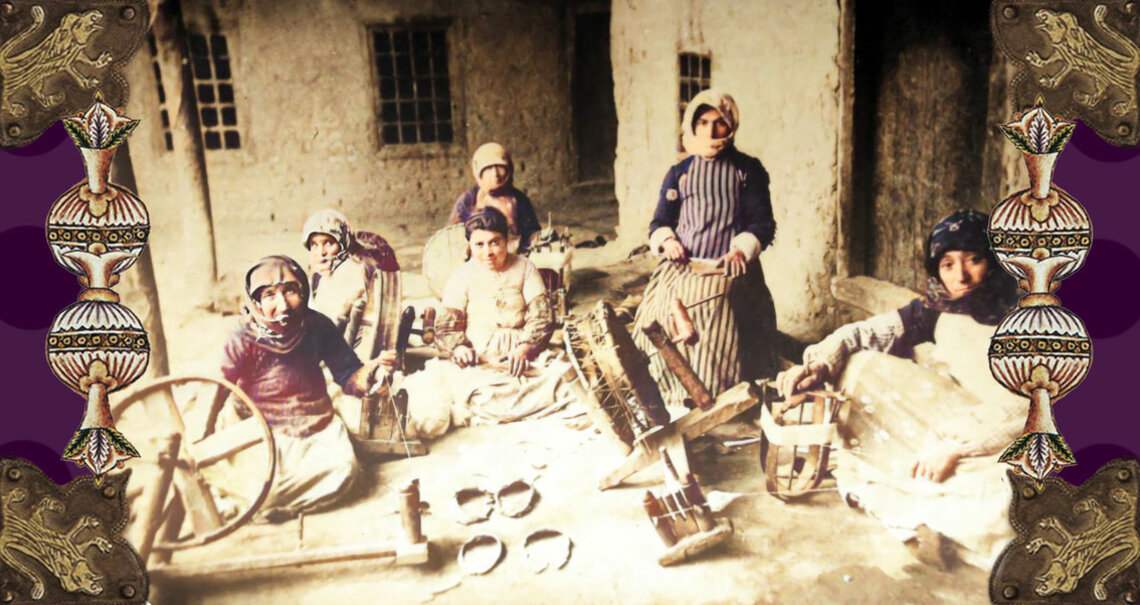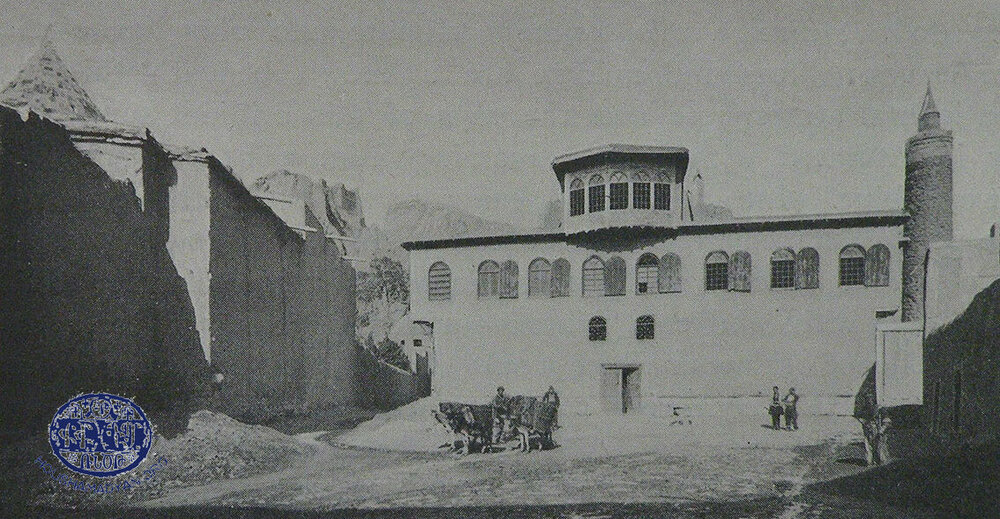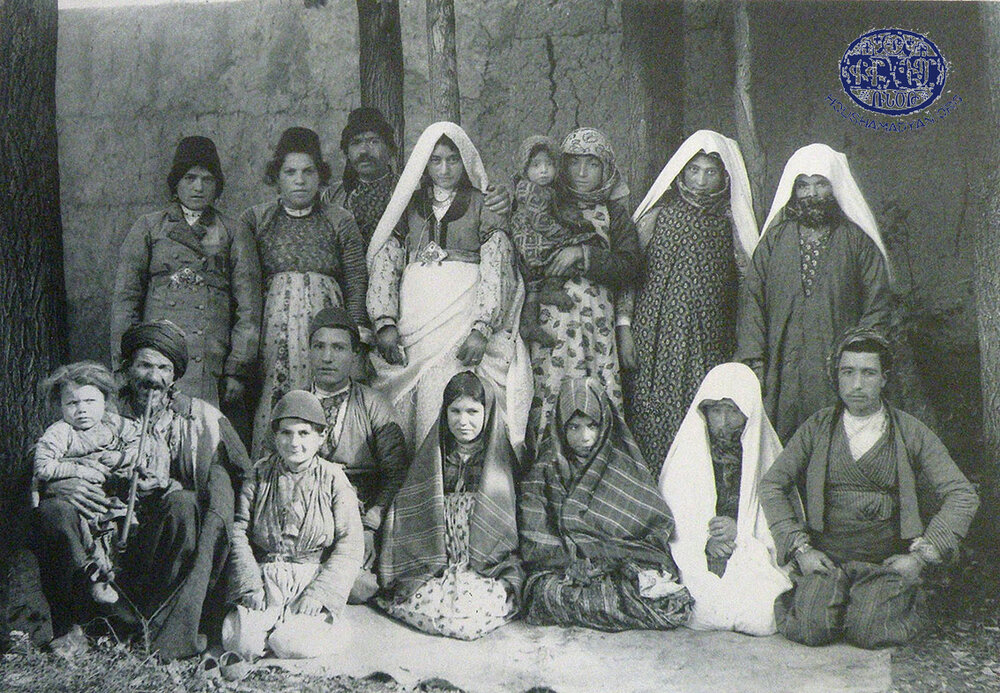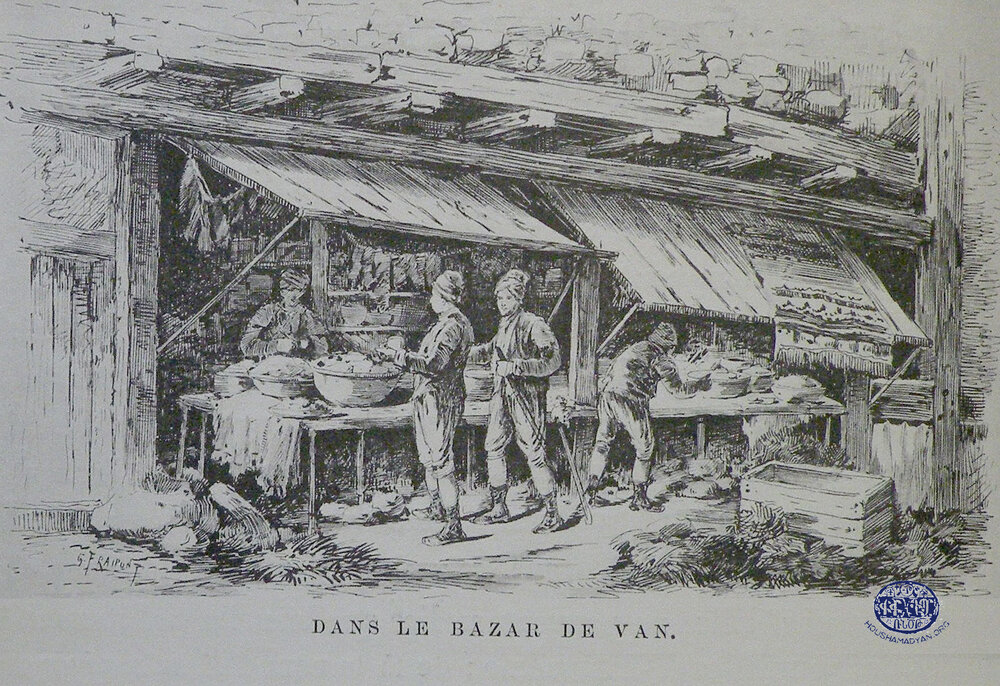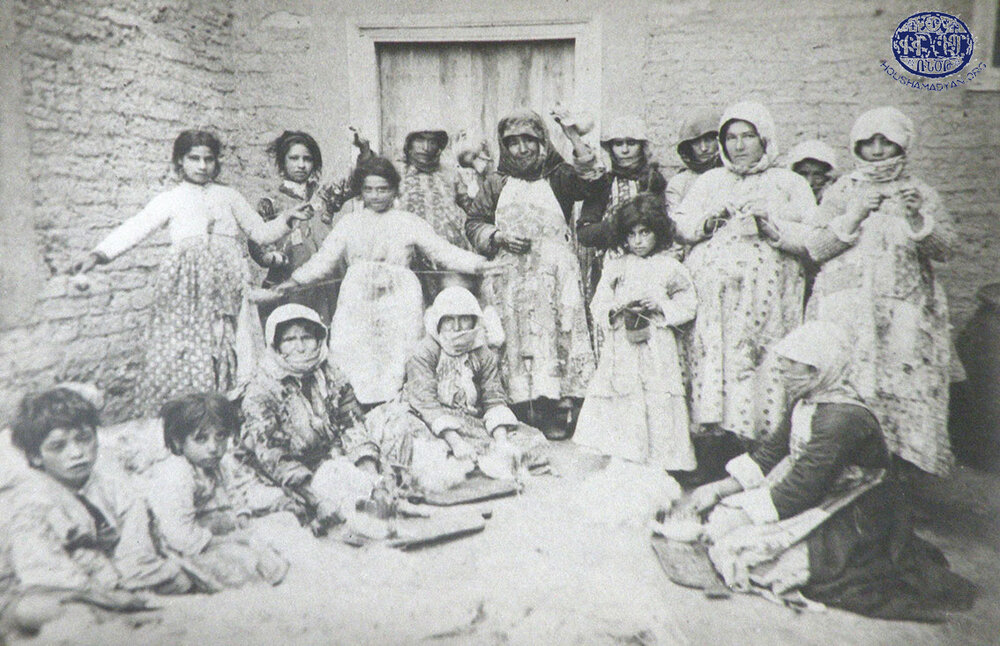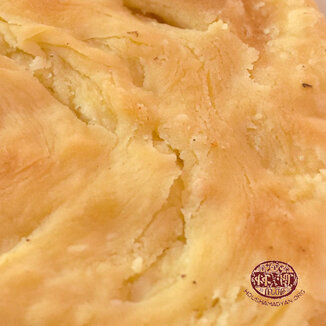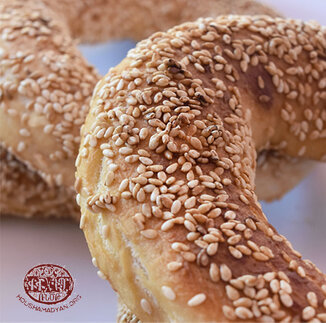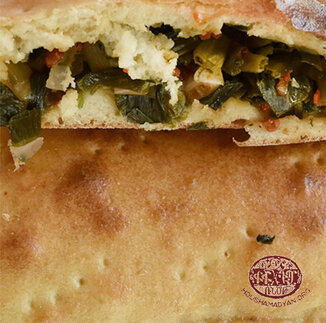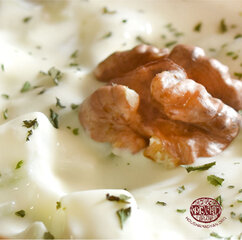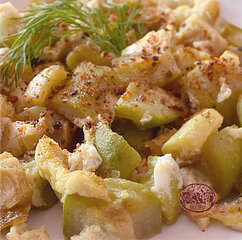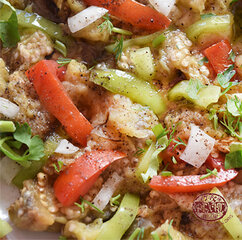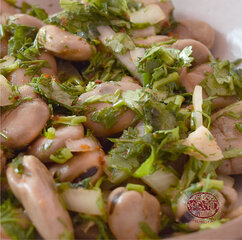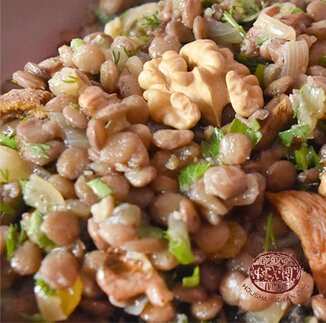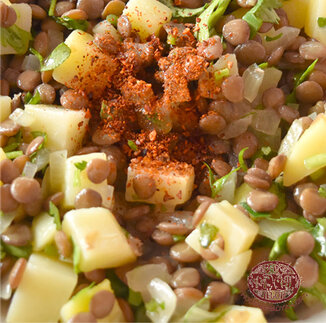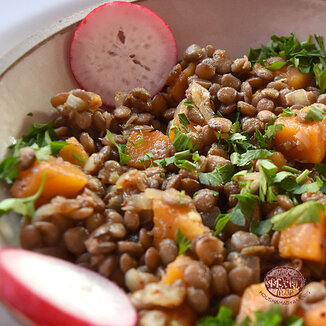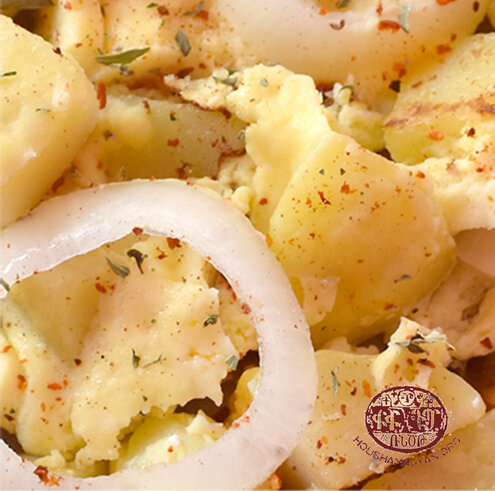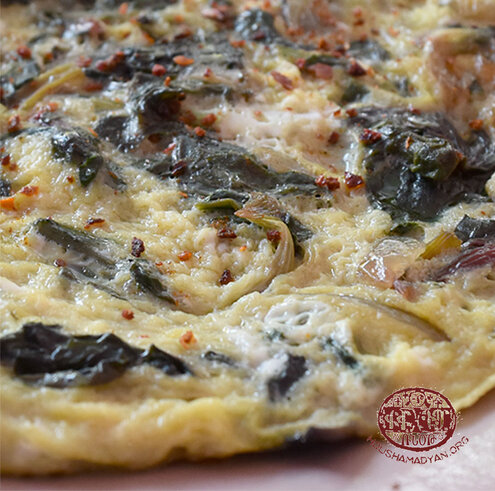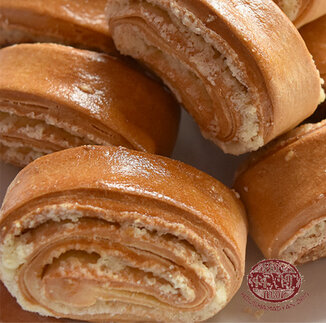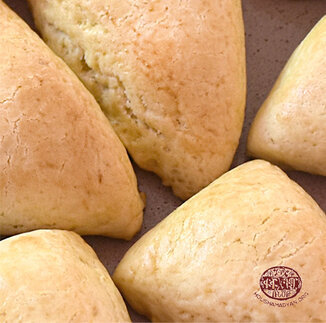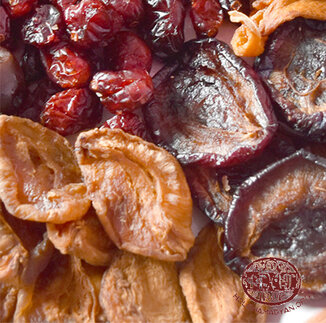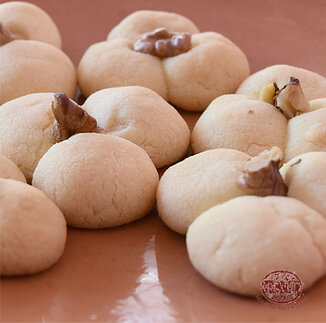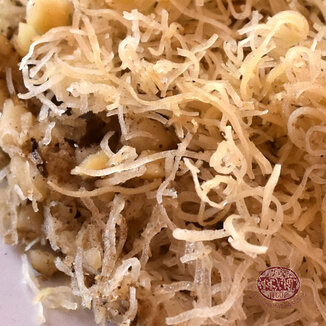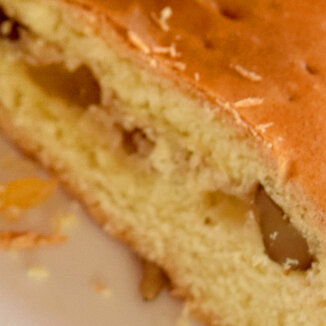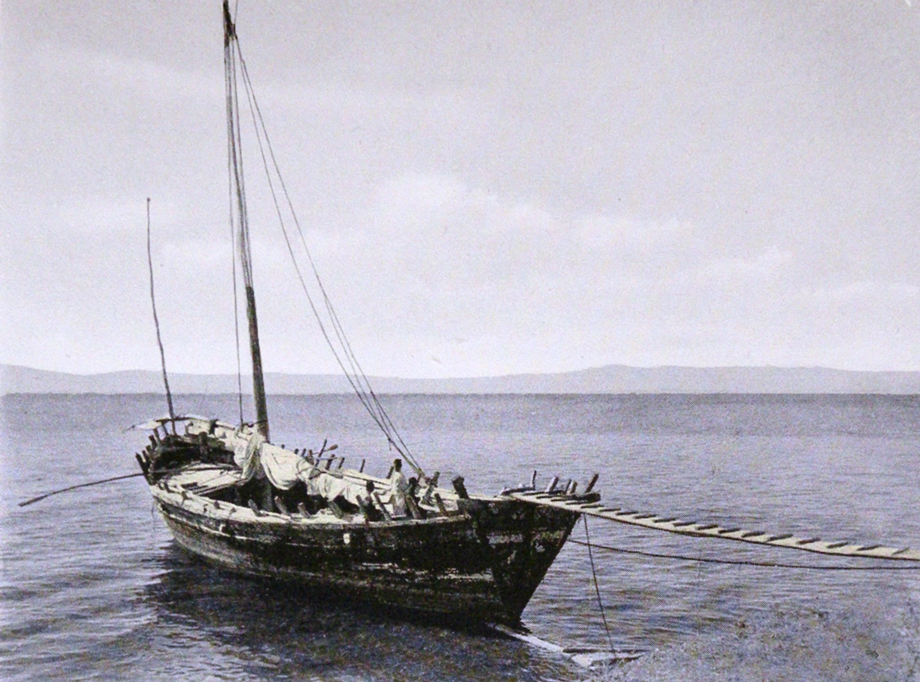Van – Cuisine
Author: Sonia Tashjian, 14/02/2023 (Last modified: 14/02/2023) - Translator: Simon Beugekian

In terms of its urban architecture, Van was unique among cities founded in medieval times, reflecting its distinctive and rich culture. The city was built at the foot of Mount Varak. In the middle of the city, at the peak of a hill, was the ancient fort. An adequate water distribution system had served Van since antiquity, consisting of a network of canals and wells. The layout of the streets was designed with care. The typical exterior appearance of the buildings was reminiscent of the city’s noble past, which was also manifested in the appearance of the city’s markets, market inns, and craftsmen’s quarters; as well as the locals’ refined customs, habits, and bearing. These traits also influenced the local cuisine, which was characterized by a diversity and abundance of dishes, a propensity to serve multiple dishes simultaneously, and the unique appearance and methods of preparation of dishes.
The locals picked nuts and wild herbs from the forests and foothills in the countryside around the city. One of the area’s native species was a type of truffle known as tompala. In late autumn, a type of potato called moudjoughez was harvested. This potato was eaten raw or pickled.
Grains were hauled into the city from the surrounding countryside on large chariots. Each household would store an amount proportional to the number of its members. Some of the grain was cleaned and boiled, then hulled to make groats. The rest was taken to the mill and ground into flour. The next priority was lentils, a local favorite used in many local dishes. Other commonly used cereals and grains included emmer, beans, corn, chickpeas, peas, rice, and broad beans.
Like all large cities in the region, Van was home to large markets, where a variety of goods were sold, many imported from faraway countries and cities by caravans. The locals procured produce, cereal, wine, oil, cheese, and other staples from the nearby countryside. The city was also home to specialized food stores, including a slaughterhouse, a butcher, a bakery, a confectionary, and stores that sold dried fruits, seeds, cheese, and honey. Van was also home to a water mill, an oil press, a wine press, etc.
Samovar culture infiltrated Van in the early 1800s. In wealthy homes, tea and coffee were ceremonially served after meals, accompanied by the appropriate desserts. The city was home to many ghayfakhans (coffee houses), chaikhanas (tea houses), and meikhanas (wine houses), where the men gathered to discuss news and recent events. The servers at these establishments were teens, and they would also deliver tea and coffee to nearby stores and businesses in return for a small fee. In the hot summers, cold juices and dondourma (ice cream) were sold from carts.
In the countryside, the locals would have a hot breakfast in the morning; cheese, bread, and tea at noon; and their main meal in the evening. Customs differed in the city, where residents would eat a light breakfast early in the morning, called khats or agrasd. The hot meal enjoyed before going to work was called djashots. The principal meal of the day, enjoyed at noon, was called khraments. Evening supper was called huntris. Before going to bed, city residents had their bashiv, a meal consisting of yogurt and okroshka soup.


Bread Products
The most popular type of bread in Van was lavash bread. Each family would bake bread for daily use in the home’s tonir. Several months’ worth of bread would be baked at a time. Unlike in other areas of Ottoman Armenia, Armenians in Van baked lavash into circular loaves, which were then folded, dried, and preserved in sacks hanging from the ceiling of the bread room.
Bakeries operated across the city, but families also had the custom of baking lavash on saj (tava). The people of Van enjoyed many other varieties of bread, some of which could only be found in the city, while others were bought in the nearby villages. In the countryside, the locals baked babadjig and toghig bread on a daily basis. They baked batskhats (lavash) only rarely.
Traditional lavash, consumed daily, was round and very thin. Losh, or loshig, was a thicker type of lavash. Glodj was made with unleavened dough, kneaded in the water mills, and baked into small, saucer-shaped rolls. Sankak was the name given to oval loaves of soft bread with a thickness of about one centimeter, marked with the fingers. Taptagan or piden were flat and round loaves, with a hole in the center; while toghig was the oval version of taptagan or piden. Babadjig was round, soft, with a thickness of two centimeters, puffed, and with a hole in it. Somon was elongated and puffed, and only baked by the city’s bakeries. Pogegh was a soft, round pastry, made with oil and grape syrup on holidays.
Oghig was a ring-shaped loaf of bread, which was made by dipping dough first into a mixture of water and grape syrup and then into koundjit before baking it. Grgoud was a loaf of thin and firm bread, which was crumbled into soups. Gurtgurtig was dry bread that was suitable for long journeys. Goregdjat (or corn gloren) was bread baked with corn flour. Other types of bread enjoyed in Van included taparig, mokhrig, goud, gdeni, dumproz, etc.
Sokhoug Bread (Lenten)
Chop and season plenty of scallions and garlic. Flatten the dough with a rolling pin, spread the filling of scallions and garlic in the center, then fold the dough back by joining the ends. Flatten with the fingers, rub water on top, then bake.
Cheese Bread
For the filling, chop scallions and herbs, then mix with grated cheese or pot cheese and spices. Flatten the dough with a rolling pin, spread the filling in the center, and daub the dough with butter. Fold the dough back by joining the ends, then flatten, rub egg on top, and bake.
Goudab (Lenten)
The term goudab is a synonym for beoreg. For the filling, chop scallions and wild herbs (if necessary, boil and drain; wild herbs can also be replaced by spinach or goosefoot). Flatten the dough with a rolling pin, add the filling, fold the dough by joining the ends, flatten again with wet fingers, and bake.

Lentil Goudab (Lenten)
For the filling, mix boiled lentils, fried onions, chopped herbs, raisins, walnuts, and red and black ground pepper. Flatten bread dough with a rolling pin, spread the filling in the center, then fold the dough back by joining the ends. Flatten with the fingers, rub water on top, and bake.
Djumur or Mudjour
Upon removing warm bread from the oven, crumble it in oil. According to preference, add grape syrup and sugar, or pot cheese.
Beaghardj
Knead the dough of regular bread with milk instead of water. Make round, flat buns. Rub milk skin on top, then bake. Beaghardj with khoris was made in the same way, but by splitting the buns into two halves, filling the bottom half with khoris (flour, oil, and sugar), replacing the top, flattening with the fingers, rubbing egg on top, and baking.
Paynakosh or Beaghardj with Oil (Lenten)
Knead the dough of regular bread with oil alongside water, then make round, flat buns. Rub water on top, sprinkle with sesame, and bake.
Grgeni or Midjnablit (Lenten)
This was a special type of bread baked on mid-Lent. A coin was placed in the bread, as a token of good fortune for the person who found it. It was made with regular bread dough, but oil and a small amount of sugar were added to the water used to knead. After allowing the dough to rise, raisins and chopped nuts were also mixed into it, then the dough was shaped into loaves and baked.
Pournig
Two different versions of this dish were made. One was sweeter, and involved baking regular bread after mixing chopped dried fruits, raisins, and nuts in the dough. The other version was dough filled with jajig (see the recipe of jajig below).

Salads
The people of Van customarily served salads alongside main dishes and pilafs.
Eggplant Salad
- 2 roasted eggplants
- 1 pepper
- 1 tomato
- 1 onion
- Herbs
- Oil
- Red and black ground pepper
- Salt
Clean and chop the eggplants, then chop the pepper, tomato, onion, and herbs. Season, mix, and serve.
Dried Eggplant Salad
Eggplants were dried during the hot summers. They were peeled, chopped, salted, and left to dry in the sun. There were two ways to dry the eggplants – one was to hang them from a string in the sun, the other was to arrange them on a screen. This salad was a staple of New Year’s celebrations.
Soak the dried eggplants in water for a few hours, then change the water, boil, and drain. In the absence of dried eggplants, peel and chop fresh eggplants, sprinkle with salt, leave in a colander for an hour, then drain and use.
- 1 cup of dried eggplants (or 3 fresh eggplants)
- 2 onions
- 1/2 cup of chopped walnuts
- 1/2 cup of pomegranate seeds
- Herbs
- Oil
- Red and black ground pepper
- Salt
Chop the onions and eggplants. Steam boil in oil over a low fire and with the lid covered. After letting the vegetables cool down, add the chopped herbs and walnuts and garnish with the pomegranate seeds.
Jajig
To make jajig, mix milk and yogurt, curdle by boiling, then strain by pouring into a bag.
- 1/2 kilogram of quark
- 1 hot pepper
- Dill
- Spices
- Basil
- Mint
- Scallions (according to preference)
- Salt
Chop the pepper and vegetables and mix them with the quark.
Yogurt Salad
Dilute strained yogurt with a small amount of water, then add chopped cucumbers and powdered mint. Also add crushed garlic, according to preference. Garnish with chopped walnuts.
Djadjukh
- 1 boiled egg
- 1 boiled beet
- 1 cucumber
- 1 onion
- 1 clove of garlic
- 1 cup of yogurt
- 1 cup of strained yogurt
- Herbs
- Black pepper
- Salt
Chop the produce. Mix the yogurt and strained yogurt well, then add the chopped produce. Season and serve.
Salad with Broad Beans
This was a dish prepared on the first day of Lent. It was sour and spicy. Boil the broad beans (dried or fresh), strain, then set aside to cool down. Mix in the chopped onions, chopped herbs, spices (hot red and black pepper, caraway, and coriander seeds), oil, and vinegar.
Hadkhash (White Beans)
Boil the white beans, drain, then set aside to cool down. Mix in the chopped onions, chopped herbs, and spices (red and black ground pepper, caraway, and coriander seeds). Add oil and vinegar.
Gulumpoz (Beet) Salad
Boil and chop the beets, drain, then set aside to cool down. Mix in the chopped onions, salt, pepper, sumac, oil, and vinegar. Garnish with chopped herbs.
Potato Salad
- 3 boiled potatoes
- 1 onion
- 1 pickled cucumber
- Herbs
- Oil
- Hot red pepper
- Caraway
- Thyme
- Salt
Chop the potatoes, onion, pickle, and herbs, then season and mix the ingredients together. In the summer, tomatoes and peppers were also added to this salad.
Imam Bayildi
- 2 eggplants
- 2 green peppers
- 2 tomatoes
- 2 onions
- 2 cloves of garlic
- Oil, for frying
- Herbs
- Red and black ground pepper
- Caraway
- Allspice
- Salt
Cut the eggplants and peppers into long strips and fry. Then put out the flame, add the chopped tomatoes, onions, and garlic; season; cover with the lid, then set aside to cool down. The heat will soften the tomatoes and onions. Sprinkle the chopped herbs on top.
Mshosh
Mshosh was one of the ceremonial dishes of Van. Its main ingredient was lentils. Traditionally, mshosh was made with dried apricots. In the Van dialect, mshmosh was the term for a type of small, wild apricot. The name of the dish likely originated with this word. In later years, alternative versions of the dish made with vegetables and that could be prepared for daily consumption were created, and the dish became popular not just in Van, but also other parts of historic Armenia.
- 1 cup of lentils
- 1 onion
- 1/2 cup of chopped dried apricots
- 1/2 cup of chopped prunes
- 1/2 cup of chopped walnuts
- 1/2 cup of raisins
- Oil
- Red and black ground pepper
- Thyme
- Salt
Boil the lentils, drain them, and set aside to cool down. Chop the onion, steam boil in oil, and add the lentils and seasoning. Then mix in the dried fruits, raisins, and walnuts. Continue to cook for another few minutes, then allow to cool down. Garnish with herbs.
Gulumpoz (Beet) Mshosh: Add fried onions, boiled and chopped beets, herbs, and spices to the lentils. According to preference, also crush a clove of garlic and add to the mix.
Ddme Mshosh:Add fried onions, boiled and chopped zucchinis, herbs, and spices to the lentils. According to preference, also crush a clove of garlic and add to the mix.
Mshosh with Dabghin: Add fried onions, boiled and chopped carrots, herbs, and spices to the lentils. According to preference, also crush a clove of garlic and add to the mix.
Mshosh with Potatoes: Add fried onions, boiled and chopped potatoes, herbs, and spices to the lentils. According to preference, also crush a clove of garlic and add to the mix.
Mshosh with Green Beans: Add fried onions, boiled and chopped green beans, herbs, and spices to the lentils. According to preference, also crush a clove of garlic and add to the mix.

Omelets
Omelet: Beat 4 eggs with 2 tablespoons of flour and salt. Pour into a pan coated in hot oil, and fry both sides. According to preference, add honey or grape syrup.
Cheese Omelet: Beat 4 eggs with 1/2 cup of milk. Add ½ cup of flour and salt. Pour into a pan coated with hot oil, then sprinkle with the grated cheese, chopped herbs, and spices.
Kima/Ghiyma with Eggs: Heat the finely diced pre-cooked meat in its own oil, then add a few beaten eggs and sprinkle with hot red pepper. Omelet with ghavourma was prepared in the same way.
Omelet with Mixed Vegetables: Boil mixed vegetables, drain, then fry in oil before adding a few beaten eggs.
Omelet with Potatoes: Fry 1 chopped potato, season, then add 2 beaten eggs. Serve with a chopped onion, with thyme and red pepper sprinkled on top.
Omelet with Artichoke: chop 1 onion and 1 artichoke, fry in oil, then add a few beaten eggs. Garnish with chopped herbs
Mukhla: A vegetable omelet. Chop 1 zucchini (or a similar vegetable) and fry in oil. Beat 1 egg in ½ cup of yogurt, crush garlic into the mixture, then pour it over the zucchini. Season, garnish with herbs, and serve.
Kmkhla: Chop 2 boiled beets, mix with 2 beaten eggs, and add spices. Pour into a pan coated with hot oil and fry.
Green Bean Porani: Fry boiled green beans with onions, then pour several eggs into the pan and continue frying. Sprinkle with fennel seeds and serve with garlic yogurt.

Yogurt-Based soups
Yogurt-based soups were served after each meal. A variety of soups were made with boiled fresh yogurt, tan (doogh) from the churn, and chortan (dried tan). Many different ingredients were used, with many different names. The words bas or sbas are not related to the word bahk (Lent), they simply mean “soup.”
These soups were garnished with chopped, fresh shoots of herbs. Sometimes, they were also garnished with the petals of orange and blue flowers. This was a custom that only the urbane housekeepers of Van could have devised.
The boiled yogurt mentioned in the following recipes was prepared thus: 1 egg and 1 tablespoon of flour were mixed into one liter of yogurt before boiling. In this way, the yogurt would not coagulate. For the fried onion, chop the onions, then steam fry with a small amount of oil or vegetable oil. A day before using it as an ingredient in a dish, immerse the chortan in warm water, and when it softens, crush it in the water until the liquid becomes homogeneous and the lumps dissolve.
Tankhash: The simplest form of yogurt soup. Mix a small amount of flour into the butter from the churn, boil, then our oil on top and serve.
Tankhous: Mix a small amount of fine groats into boiled tan or yogurt and boil until the mixture thickens slightly. Serve after dripping oil on top.
Tan Soup: Pour the boiled yogurt on boiled dzedzadz (hulled wheat; spelt), then add the fried onions and dried wild herbs (thyme, wild mint, or fresh spices).
Tantana: Fried the hulled wheat with an onion chopped into rings. Then add the boiled yogurt and sprinkle celery on top.
Torvanbas or Vosbntan: Torva was another word for tonir. Most probably, in years past, this dish was cooked in a tonir. A small amount of flour was mixed into the tan from the churn (or yogurt). The mixture was boiled. Rshda (homemade pasta), then boiled lentils were added to it. The whole mixture was then boiled together, and fried onions added. The soup was served with fresh or dried basil on top, and on holidays, with strips of ghavourma meat.
Tan Soup or Tavebas: Boiled the crushed hulled wheat, mix in the rshda (homemade pasta), the boiled yogurt, and then the fried onions. Serve with chopped herbs on top.
Yogurt Soup: Pour water into boiled yogurt. Add a handful of coarse groats, chopped spinach or milfoil, and continue cooking.
Yogurt Soup with Artichoke: Boil the artichoke with onions, then pour the boiled yogurt into the pot, boil the ingredients together, and serve with chopped herbs.
Chortan Dish: Crush garlic into chortan boiling in water. Boil hulled wheat. Fry onions in oil, and season with hot red pepper. Serve with the hulled wheat in a bowl and the boiled chortan poured on top. Make a dip in the center and fill it with the fried onions.
Aragatan: Crush garlic into chortan boiling in water. Then add the previously boiled hulled wheat. After pouring into a bowl, make a dip in the center and fill it with oil.
Aragadjash: Crush garlic into chortan boiling in water. Then mix in the boiled groats. Fry onions in oil and season with hot red pepper. Serve with the fried onions on top.
Sokhatan: Mix flour into the tan of the churn and boil. Chop onions into rings, add to the tan, and continue boiling.
Summer Tan Soup: Boil hulled wheat, then set aside to cool down. Dilute the yogurt with a small amount of water, pour it over the wheat, sprinkle with ground red pepper, and garnish with fresh or powdered mint.
Djashetan: Pour cold tan on boiled coarse groats and serve.
Mehir: Boil coarse groats. After letting it cool down, pour yogurt on the groats. According to preference, add crushed garlic, fresh mint, or basil leaves.
Pshroug with Tan: Add water and salt to flour and knead the dough until it’s firm. Using the fingers, tear the dough into small strips. Boil these strips in saltwater until they rise to the surface. Mix in boiled tan or chortan, add fried onions, and continue to boil. Serve with chopped herbs on top.

Soups
Askuli
- 200 grams of finely diced oily meat
- 1/2 kilogram of pickled herbs (or spinach)
- 2 onions
- 4 cloves of garlic (or 2 shoots of scallions)
- 1 lemon, for the juice
- 4 eggs
- Red and black ground pepper
- Mint
- Sumac
- Salt
Chop the onions and fry with the meat. Add the chopped herbs, garlic, and water, season, and boil. Add the lemon juice, then crack the eggs one by one carefully into the soup. Cover the pot with the lid, and boil until the eggs are cooked. Serve with the egg yolk unbroken.
Pshroug (Lenten)
Add salt and water to flour, then knead the dough until it’s firm. Using the finger, tear the though into strips. Dissolve tomato paste into boiling water, season with red and black ground pepper, then boil the strips of dough in this mixture until they float to the surface of the water. Serve with chopped herbs. On non-Lenten days, butter or oil was added to the recipe.
Vosbunebas (Lenten)
- 1 cup of lentils
- 1/2 cup of fine groats
- 2 onions
- 1 head of garlic
- 1/2 cup of chopped walnuts
- Sour grape molasses
- Red and black ground pepper
- Salt
Boil the lentils, then mix in the chopped onions and garlic. At the same time, mix in the groats and spices, then add the walnuts and sour molasses.
Soup with Monk’s Rhubarb (Lenten)
- 1 bundle of monk’s rhubarb
- 1 cup of lentils (or coarse groats)
- 2 onions
- 1 head of garlic
- Chopped walnuts and sour grape molasses
- Red and black ground pepper
- Salt
Boil and then drain the rhubarb. Boil the lentils, add the boiled rhubarb, add the fried onions and garlic, and continue cooking. Mix in the walnuts, sour molasses, and spices.
Dish with Eghedj
Pour water on fried onions. Add red and black ground pepper, salt, and coarse groats, then continue cooking. Mix in the yeghindj (nettles), boil, and remove from the flame.
Pickles with Gorgod (Lenten)
- 1/2 kilogram of pickled cabbage
- 2 onions
- 2 potatoes
- 1/2 cup of coarse groats
- 1/2 cup of prunes
- Oil
- Herbs
- Thyme
- Ground red pepper
- Salt
Chop the pickled cabbage, boil in plenty of water, add the chopped potatoes, prunes, and spices, then mix in the groats and fried onions. Boil until all the ingredients soften. Sprinkle with chopped herbs before serving. Add the salt only after tasting, as the sour taste of the pickled cabbage may be sufficient for some.
Shgleg
- 1/2 kilogram of cabbage
- 2 onions
- 2 potatoes
- 1 tablespoon of tomato paste
- 1 tablespoon of oil
- Herbs
- Red and black ground pepper
- Salt
Chop the vegetables and boil them together, then mix in the oil, tomato paste, and spices, and continue boiling. Serve with chopped herbs on top. During Lent, this dish was made with vegetable oil.
Gandjrgobas (Lenten)
Gandjrag (safflower) is a thorny bush with orange flowers and seeds that resemble sunflower seeds. These seeds were boiled, crushed in a mortar, and the milky oil extracted from them. The oil was then used for various dishes.
- 1 onion
- 2 cloves of garlic
- 1 carrot
- 1 potato
- 1/2 cup of coarse groats
- 2 tablespoons of oil
- Herbs
- Red and black ground pepper
- Salt
Steam boil the chopped onion, garlic, carrot, and potato in oil. Add the spices, boil with plenty of water, then add the chopped herbs on top.
Makhokh (Lenten)
Chop pickled cabbage, onions, and garlic, and boil together in plenty of water. Add a small amount of coarse groats, dried herbs, and spices; and continue boiling.
Chickpea Soup
- 1 cup of boiled chickpeas
- 1 onion
- 1 potato
- 3 cloves of garlic
- 1 tablespoon of flour
- Sour bastegh (fruit leather)
- Herbs
- Vegetable oil
- Red and black ground pepper
- Salt
Chop and boil the potato with the garlic. Add the chopped bastegh, spices, boiled chickpeas, and fried onions, then continue boiling. Thicken the flour with cold water and mix into the soup, then sprinkle the chopped herbs on top.
Djurdjyour or Djvchour (Lenten)
- 1 kilogram of zucchinis
- 2 onions
- 2 tablespoons of oil or vegetable oil
- 1/2 cup of rice
- Herbs
- Red and black ground pepper
- Salt
Chop the onions, steam boil in oil or vegetable oil, then add the cubed zucchinis, the rice, and the spices. Continue cooking over a low flame. Serve with chopped herbs on top.
Chulpour
- 3 onions
- 3 cloves of garlic
- 3 eggs
- 2 tablespoons of oil
- Stale bread
- Herbs
- Red and black ground pepper
- Thyme
- Salt
Chop the onions and garlic, then steam boil in oil. Season and add water. After the water starts boiling, slowly add the beaten eggs while stirring rapidly. Sprinkle the chopped herbs on top after removing from the flame. Pour the chulpour over stale pieces of bread and serve alongside radish, onions, or pickles. During Lent, this dish was made without eggs and garnished with walnuts, while onions and garlic were steam boiled in vegetable oil.
Chulpour with Mushrooms
- 1/2 kilogram of mushrooms
- 1 carrot
- 1 pepper
- 1 onion
- 1 tomato
- 2 tablespoons of oil
- Herbs
- A handful of rice
- Red and black ground pepper
- Salt
Chop the vegetables, steam boil in oil, add the water and spices, and continue boiling. Mix in the rice and continue boiling over a low flame until all the ingredients are cooked. Serve with chopped herbs sprinkled on top.
Sivtgoun Soup
- 1/2 kilogram of white goosefoot
- 1/2 cup of coarse groats
- 1/2 cup of prunes
- 2 onions
- 2 tablespoons of oil or vegetable oil
- 2 tablespoons of flour
- Red and black ground pepper
- Salt
Chop and boil the goosefoot, then add the groats and the prunes. Meanwhile, chop the onions and steam boil in oil. Thicken the flour with water. Add the fried onions and flour to the boiling soup, and continue boiling for ten minutes.

Shilas (Porridges)
Samir: Cook ground corn in milk, with salt added. When serving in bowls, make a small dip in the center of the dish, and fill it, according to preference, with grape syrup to sweeten the dish.
Khavidz: Roast 1 cup of flour with 2 tablespoons of oil until the flour turns golden, then slowly pour in the water, stirring constantly, until the liquid thickens into a porridge. According to preference, add salt or sugar. Continue cooking over a low flame, until the oil floats to the surface with each simmer. For children, khavidz was made with starch.
Khashil: Pour water over ½ cup of pokhints (kama/talqan) or fine groats. Add salt and boil while stirring constantly until the mixture thickens into a porridge. After pouring the porridge into a bowl, make a dip in the center and fill it with oil, then pour boiled tan or milk on the edges of the bowl before serving.
Djash: Mix unroasted flour with melted oil, then add water and boil. Pour grape syrup on top before serving. This dish could also be made by mixing flour (or ground fine groats) with water or water and grape syrup, cooking over a low flame, and serving with oil on top.
Vrosh (Lenten)
- 1 cup of lentils
- 1 cup of fine groats
- 1/2 cup of walnuts
- 1 head of garlic
- Red and black ground pepper
- Caraway
- Salt
Boil the lentils, add the groats and spices, then continue cooking until the mixture becomes homogeneous. After removing from the flame, mix in the ground walnuts and crushed garlic.
Vosbenbas (Lenten)
- 2 cups of lentils
- 2 onions
- 1/2 cup of walnuts
- Pickled prunes or grape bastegh (grape leather)
- Red and black ground pepper
- Caraway
- Salt
Boil the lentils with the chopped onions, then mix in the remaining ingredients and continue boiling over a low flame.
Pfig: This was a simple Lenten dish, prepared by boiling flakes of groats in water.
Malez or Lamez: Thicken flour with milk, mix in sugar or salt, and boil. Serve after dripping melted oil on top.
Arkhav: Thicken flour with water and add sugar or salt. Mix in a small amount of oil.
Asita or Hasouta: Thicken flour with water, mix in grape syrup and a small amount of oil, then boil.

Pilafs
Pilafs were a stable of the Van diet, usually served as side dishes. The Armenians of Van had a unique custom of serving a special sauce alongside pilafs. This sauce was made with grape syrup, cooked dried fruits, tomato paste, and spices. To make pilafs, the people of Van usually used coarse groats, rice, lentils, and rshda (homemade pasta). In the Van dialect, dzavru/dzavre was the word for groats (bulgur).
Dzavre Pilaf with Ground Meat
- 200 grams of ground meat
- 2 onions
- 3 cloves of garlic
- 1 cup of coarse groats
- 2 cups of water
- Red and black ground pepper
- Caraway
- Mint
- Salt
Fry the ground meat, chopped onions, and garlic in the meat’s own oil. Add the groats, spices, and water, and continue cooking over a low fire until the water is completely absorbed.
Dzavre Pilaf with Tomatoes
- 2 onions
- 2 tomatoes
- 2 peppers
- 1 tablespoon of oil or vegetable oil
- 1 cup of coarse groats
- 1 1/2 cups of water
- Herbs
- Red and black ground pepper
- Caraway
- Salt
Chop the onions, steam boil in the oil, then add the chopped tomatoes and peppers. Continue boiling, then add the groats, spices, and water. Continue boiling over a low fire until the water is completely absorbed. Serve with chopped herbs on top.
Dzavre Pilaf with Broad Beans
- 2 onions
- 1 cup of boiled broad beans
- 2 tablespoons of oil or vegetable oil
- 1 tablespoon of tomato paste
- 1 cup of coarse groats
- 2 cups of water
- Herbs
- Red and black ground pepper
- Caraway
- Salt
Chop the onion, steam boil in oil, then add the tomato paste and spices. Then mix in the groats, broad beans, and water. Cook over a low flame until the water in completely absorbed. Serve with chopped herbs on top.
Dzavre Pilaf with Potatoes
- 2 onions
- 2 potatoes
- 2 tablespoons of oil or vegetable oil
- 1 tablespoon of tomato paste
- 1 cup of coarse groats
- Herbs
- Red and black ground pepper
- Caraway
- Salt
Chop the onions, steam boil in oil, then add the chopped potatoes and continue cooking. Then mix in the groats, tomato paste, spices, and water. Cook over a low flame until the water in completely absorbed. Serve with chopped herbs on top.
Pilaf with Rshda
Boil the rshda (homemade pasta), then drain. According to preference, fry with onion or just with oil. Season by adding red and black ground pepper and herbs.
Dzavre Pilaf with Rshda
- 2 onions
- 2 tablespoons of oil or vegetable oil
- 1 cup of coarse groats
- 2 cups of water
- 1/2 cup of rshda (homemade pasta)
- Red and black ground pepper
- Caraway
- Salt
Chop the onions and steam boil in oil. Add the groats, spices, and water. Cook over a low flame. Separately boil the rshda, drain, then mix with the pilaf. Continue boiling until the water is completely absorbed.
Easter Pilaf
- 2 cups of rice
- 4 cups of water
- 4 tablespoons of oil
- 1/2 cup of raisins
- 1/2 cup of nuts
- 1/2 cup of chopped dried fruits
- Salt
Boil the water, then add the salt, half the oil, and the rice. Boil over a low flame. Separately, steam boil the dried fruits, raisins, and nuts with the remainder of the oil and ½ cup of water. While the rice is still boiling and while there is still water in the pot, mix in the other boiled ingredients. Alternatively, the boiled ingredients could be spread on top of the rice before serving.
Rice Pilaf with Rshda
- 1 cup of rice
- 2 cups of water
- 1 tablespoon of oil
- ½ cup of rshda (homemade pasta)
- Salt
Boil the rice by pouring it into boiling saltwater. Separately, boil the rshda, strain, steam boil in oil, then mix into the rice while the water is still not completely absorbed.
Rice Pilaf with Dates (or Raisins)
Boil the rice in saltwater. Separately, steam boil the dates and mix them into the rice while the saltwater is not yet completely absorbed.
Rice Pilaf with Gangar (Artichokes)
- 1 cup of rice
- 2 cups of water
- 1 tablespoon of oil
- 1 onion
- 2 artichokes
- Black pepper
- Salt
Chop the onions and artichokes and steam boil with oil. Add the rice, water, black pepper, and salt, then cook over a low flame until the water is completely absorbed.
Gourgoud
Boil cracked wheat (gorgod). Add oily ghavourma meat to the wheat and mix. Continue boiling until the water is completely absorbed.
Dish with Gorgod
Boil gorgod (cracked wheat), add finely chopped beet greens, then continue boiling. Serve with fried onions on top, sprinkled with red pepper.
Pilaf with Shrez
- 1/2 kilogram of eremurus (shreshd) or beet greens
- 1 onion
- 2 cloves of garlic
- 1 tablespoon of tomato paste
- 1 tablespoon of oil
- 1 cup of coarse groats
- 2 cups of water
- Red and black ground pepper
- Salt
Chop the vegetables, steam boil with the chopped onion and the garlic, then add the coarse groats, tomato paste, water, and spices. Cook over a low flame until the water is completely absorbed.
Pilaf with Rye
Chop 2 onions and 1 head of garlic. Steam boil with 2 tablespoons of oil. Then add 2 cups of rye and 4 cups of water, as well as hot red pepper. Cook over a low flame until the water is completely absorbed.
Lentil Pilaf
- 1 cup of boiled lentils
- 1 cup of rice (or coarse groats)
- 2 cups of water
- 2 onions
- 2 tablespoons of oil
- Red and black ground pepper
- Salt
Boil the rice (or groats) in water, then add the lentils that have been previously boiled and set aside to cool down. Season. Chop the onions, steam boil in oil, mix into the pilaf while the water is still not completely absorbed, and continue boiling for a few minutes.
Kashovi Pilaf
Chop an onion vertically, steam boil in oil with strips of ghavourma, then add hot red pepper, groats, and water. Continue boiling until the water is completely absorbed.

Dolmas
Kima/Ghiyma (Ground Meat) Dolma
- 1/2 kilogram of oily ground meat
- 1 cup of rice
- 2 onions
- 1/2 cup of chopped walnuts
- Herbs
- Red and black ground pepper
- Thyme
- Wild mint
- Salt
- Preserved grape leaves
Chop the onions and herbs. Mix with the meat, rice, walnuts, and spices. Roll the ingredients in the preserved grape leaves. Arrange the dolmas in a pot, then pour hot water over them until they fully immersed. Secure the dolmas in place using the special stone lid used for this purpose. Serve with garlic yogurt.
Ghavourma Dolma
- 1/2 kilogram of shredded ghavourma meat
- 1 cup of coarse groats
- 2 onions
- 1/2 cup of chopped walnuts
- 1 tablespoon of tomato paste
- Herbs
- Red and black ground pepper
- Thyme
- Wild mint
- Salt
- Preserved grape leaves
Chop the onions and herbs. Mix with the meat, groats, tomato paste, walnuts, and spices. Roll the ingredients in the preserved grape leaves. Arrange the dolmas in a pot, then pour hot water over them until they fully immersed. Secure the dolmas in place using the special stone lid used for this purpose. Serve with garlic yogurt.
Soghan Dolma
- 1/2 kilogram of oily ground meat
- 1 cup of rice
- 2 cloves of garlic
- 1 tablespoon of tomato paste
- Herbs
- Red and black ground pepper
- Thyme
- Wild mint
- Salt
- Large onions
Chop the garlic and herbs. Mix with the meat, rice, paste, and spices. Make a slit in the onions and leave them in boiling water for several minutes, until the wedges of the onion separate. Stuff the onions with the filling. Arrange the onions in a pot, then pour hot water over them until they fully immersed. Secure the onions in place using the special stone lid used for this purpose. Serve with garlic yogurt.
Summer Dolma
- 1/2 kilogram of ground, oily meat
- 1 cup of coarse groats or rice
- 2 onions
- 2 tomatoes
- 1 pepper
- Herbs
- Red and black ground pepper
- Thyme
- Wild mint
- Salt
- Hollowed zucchinis, eggplants, tomatoes, and/or peppers
Chop the vegetables for the filling. Add the meat, groats, and spices. Stuff the hollowed vegetables with the filling and arrange the dolmas in the pot. pour hot water over them until they fully immersed. Secure the onions in place using the special stone lid used for this purpose. Serve with garlic yogurt on top.
Basouts Dolma
Traditional basouts dolma was usually prepared on New Year’s Day. It was the most ancient of the area’s holiday dishes, once offered to the gods in expectations of a good harvest. For this reason, it was prepared with all the grains that the locals would sow as spring harvests, as well as dried fruits left over from the previous year’s harvest.
- 1/2 cup of boiled beans
- 1/2 cup of boiled chickpeas
- 1/2 cup of boiled lentils
- 1/2 cup of boiled groats
- 1/2 cup of boiled corn
- 1/2 cup of boiled peas
- 1/2 cup of rice
- 1/2 cup of chopped walnuts
- 1/2 cup of raisins
- 10 prunes
- 10 dried apricots
- 1/2 cup of tomato paste
- 1/2 cup of oil
- 5 onions
- Red and black ground pepper
- Thyme
- Wild mint
- Mint
- Basil
- Salt
- Preserved grape leaves
Chop the onions and herbs. Mix with the previously boiled and cooled cereals, walnuts, oil, pastes, and spices. Roll this mixture in preserved grape leaves. Arrange in a pot and fill the gaps with dried apricots and prunes. pour hot water over them until they fully immersed. Secure the onions in place using the special stone lid used for this purpose.
Basouts Dolma with Lentils
- 2 cups of boiled lentils
- 1/2 cup of coarse groats
- 1/2 cup of chopped dried apricots
- 1/2 cup of chopped prunes
- 1/2 cup of chopped walnuts
- 1/2 cup of raisins
- 2 onions
- Herbs
- Oil
- Red and black ground pepper
- Thyme, wild mint, and mint
- Salt
- Preserved grape leaves
Chop the onions and herbs. Mix in the remaining ingredients. Roll in preserved grape leaves. Arrange the dolmas in a pot, then pour hot water over them until they fully immersed. Secure the dolmas in place using the special stone lid used for this purpose.
Fake Winter Dolma
- 2 cups of rice or coarse groats
- 2 onions
- 1 head of garlic
- 1/2 cup of raisins
- 1/2 cup of walnuts
- 2 tablespoons of tomato paste
- 2-3 tablespoons of oil or vegetable oil
- Herbs
- Red and black ground pepper
- Thyme, wild mint, and mint
- Salt
- Dried eggplants, zucchinis, peppers, and grape or cabbage leaves
The vegetables would be hallowed out, dried, and stored in the summer. Soak the dried vegetables in water. Chop the onions, garlic, and herbs. Add the rice or groats, walnuts, raisins, paste, oil, and spices. Roll this mixture in grape/cabbage leaves or stuff the vegetables with them. Arrange the dolmas in a pot, then pour hot water over them until they fully immersed. Secure the dolmas in place using the special stone lid used for this purpose. Serve with garlic yogurt.
Fake Dolma with Kelem
- 1 cup of rye
- 1 cup of boiled dzedzadz (hulled wheat)
- 1 cup of coarse groats
- 3 onions
- 2 tablespoons of tomato paste
- 2-3 tablespoons of oil or vegetable oil
- 3 tablespoons of pomegranate paste
- Herbs
- Red and black ground pepper
- Thyme, wild mint, and mint
- Salt
- Prunes
- Pickled cabbage leaves
Chop the onions and herbs. Mix with the groats, pastes, oil, and spices. Roll in the pickled cabbage leaves. Arrange the dolmas in a pot, then pour hot water over them until they fully immersed. Secure the dolmas in place using the special stone lid used for this purpose. Serve with garlic yogurt.

Gololags/Koftas
Gloulig (Lenten)
- 1/2 cup of coarse groats
- 2 onions
- 1 tablespoon of tomato paste
- 2 tablespoons of oil or lard
- Herbs
- Red and black ground pepper
- Salt
For the kofta: - 1 cup of fine groats
- 1/2 cup of flour
- 1/2 cup of semolina
- Red and black ground pepper
- Salt
Mix the ingredients of the kofta, knead, and shape into round or oval-shaped balls. Then boil the koftas in saltwater. Add the fried onions, tomato paste, coarse groats, and herbs, and continue cooking.
Sour Gloulig/Kofta (Lenten)
- 1/2 kilogram of sour cabbage
- 3 onions
- Oil or vegetable oil, for the fried onions
For the kofta:
- 1 cup of fine groats
- 1/2 cup of flour
- 1/2 cup of semolina
- Red and black ground pepper
- Salt
Mix the ingredients of the kofta, knead, and shape into small, round balls. Boil the koftas in plenty of water, alongside the chopped sour cabbage. Pour the fried onions on top before serving.
Lentil Kofta
- 1 cup of red lentils
- 4 cups of water
- 1 1/2 cups of fine groats
- 2 onions
- Butter or oil, to fry the onions
- Herbs
- Red and black ground pepper
- Caraway
- Salt
Boil the lentils, then put out the flame and add the fine groats. Cover with the lid and set aside to cool down. Mix in the fried onions, chopped herbs, and the spices. Shape into walnut-sized nuggets.
Round Kofta
- 3 onions
- 3 peppers
- 3 tablespoons of oil
- Herbs
- Red and black ground pepper
- Salt
For the kofta:
- 1 1/2 cups of fine groats
- 1 cup of pounded meat
- Red and black ground pepper
- Caraway
- Thyme
- Salt
Mix the ingredients of the kofta, knead, and roll into walnut-sized balls. Boil these in saltwater. Steam boil the onions and peppers, chopped lengthwise, in oil. Pour the juice of the boiled koftas into the pot, then add the koftas. Cook the ingredients together for 15 minutes and serve with chopped herbs sprinkled on top.
Bloul
For the kofta:
- 1 cup of pounded meat
- 1 1/2 cups of fine groats
- Caraway
- Red and black ground pepper
- Salt
For the filling:
- 2 onions
- 200 grams of chunky ground meat
- 1/2 cup of chopped walnuts
- Red and black ground pepper
- Caraway
- Salt
For the filling, cook the chopped onions and meat, season, mix in the walnuts, and set aside to cool down. Mix the ingredients of the koftas, knead, and shape into walnut-like balls. With the fingers, make a hole in the koftas, stuff with the filling, then close the hole. Shape the koftas into balls and boil them in saltwater. Serve with chopped herbs and pomegranate seeds sprinkled on top, alongside yogurt.
Bloul (Lenten)
For the kofta:
- 1 cup of fine groats
- 1/2 cup of flour
- 1/2 cup of semolina
- Caraway
- Red and black ground pepper
- Salt
For the filling:
- 4 onions
- 1/2 cup of chopped walnuts
- 1/2 cup of raisins
- Red and black ground pepper
- Thyme
- Basil
- Salt
Mix the ingredients of the koftas, knead, shape into walnut-like balls, then use the fingers to make a hole in each. Stuff with the filling, close the holes, shape into balls, and boil in saltwater. Serve with chopped herbs and pomegranate seeds sprinkled on top.

Main Dishes
Azou
- 200 grams of oiled, ground meat
- 2 onions
- 1 head of garlic
- 5 potatoes
- 2 tablespoons of tomato paste
- 1 tablespoon of flour
- 1/2 cup of water
- Herbs
- Red and black ground pepper
- Caraway
- Salt
Fry the chopped onions, garlic, and meat in the meat’s own oil. Add the chopped potatoes and continue frying in a covered pan. Once the potatoes are cooked, add the tomato paste, then the flour thickened with water. Season and continue cooking. Serve with chopped herbs on top.
Eggplant Kebab
Although this dish was called eggplant kebab, it was actually made with tomatoes. Like in many other Armenian-populated areas of the Ottoman Empire, tomatoes did not enter the diet of Van until much later in history. In earlier years, instead of tomatoes, red eggplants were used to prepare this dish.
- 2 onions
- 5 green peppers
- 2 tablespoons of oil
- 3 eggs
- 2 loaves of loshig (a type of bread)
- Herbs
- Hot red pepper
- Salt
Chop the onions, steam boil in oil, then add the chopped tomatoes and spices. Set aside to cool down. Mix in the eggs and the chopped herbs. Spread the mixture on the loshigs placed on the bottom of a tray, spread the mixture around, and bake.
Eggplant Duzma
- 1 kilogram of long eggplants
- 400 grams of ground oiled meat
- 2 onions
- 2 tomatoes
- 1 pepper
- Herbs
- Red and black ground pepper
- Mint
- Salt
Make a two-centimeter-deep slit across the width of the eggplants, in such a way that one side remains uncut. Add the spices to the meat, mix in the chopped tomatoes, pepper, onions, and herbs, then knead the mixture with the fingers. Stuff the slit eggplants with this filling, then arrange the eggplants in a pot and cook.
Gapousga
Make several vertical slits in a one-kilogram cabbage, then place it in a pot. Fill the slits with 300 grams of ghavourma or oily meat chunks, season, and add one cup of warm water. Cover the pot with the lid and steam boil over a low flame. Serve with chopped herbs on top.
Garnyaghi
- 300 grams of ground oiled meat
- 2 onions
- 4 eggplants
- 4 peppers
- 4 tomatoes
- Red and black ground pepper
- Salt
- Oil, for frying
Lightly and individually fry the peeled eggplants and hollowed peppers and tomatoes. Separately, cook the chopped meat with the onions and season. Slit the eggplants and stuff them with the meat. Do the same with the fried peppers and tomatoes. Then pour the innards of the chopped tomatoes on top and cook.
Dudme Plol (Lenten)
- 1 kilograms of zucchinis
- 2 onions
- 2 tablespoons of oil or vegetable oil
- 2 tablespoons of tomato paste
- Herbs
- Red and black ground pepper
- Salt
Add finely chopped zucchinis on top of fried onions and cook. Add tomato paste diluted with water, chopped herbs, and spices. On non-Lenten days, kima/ghiyma meat could also be added to this dish.
Dudme Porani
Arrange 1 kilogram of zucchinis and 2 sliced onions in a pot. Add a small amount of water, place pieces of butter around the pot, and season with red and black ground pepper. Cover with the lid and cook over a low flame. Serve with garlic yogurt.
Dudme Gayle
Arrange 1 kilogram of zucchinis and 2 sliced onions in a pot. Season with red pepper and powdered cinnamon, add a piece of butter, and steam boil in a small amount of water. Serve after sprinkling with pomegranate seeds and chopped herbs. According to preference, this dish could also be made with ghavourma or kima/ghiyma meat.
Shakhgme Gayle
First, chop a turnip and boil with cloves of garlic. Drain, then add fried onions, tomato paste, and spices. Cover with the lid and cook, so that the turnip absorbs all the tomato paste. Sprinkle with chopped herbs before serving. Another version of this dish, called shalmtsrig, was made with ghavourma or kima/ghiyma meat.
Lahana Gayle (Lenten)
- 1 kilogram of cabbage
- 2 tomatoes
- 2 peppers
- 2 onions
- 1 head of garlic
- 2 tablespoons of oil or vegetable oil
- Herbs
- Red and black ground pepper
- Caraway
- Mint
- Sumac
- Salt
Cut the cabbage across and split it into several pieces. Arrange these pieces in a pot. Fill the gaps with chopped tomatoes, peppers, onions, garlic, and herbs. Add oil and spices. Cook over a low flame. According to preference, this dish could also be made with ghavourma or kima/ghiyma meat.
Okra
Pour the okra on top of the fried onions, steam boil lightly, mix in chopped tomatoes, season, and cook over a low flame without stirring. In the winters, the same dish was prepared with dried okra, ghavourma, and tomato paste.
Yakhni: This was a half-liquid dish made with oily meat and a vegetable of choice.
Urbe Dish: A dish made with flour and grape syrup.
Cold Meat: Boiled and cold meat, which was sliced and rolled in lavash bread. Usually served with soups.
Fried Meat: Boiled, then fried meat, served with soups.
Goghadz [Grilled] Darekh: The darekh fish was roasted by sticking it to the wall of the tonir, as the name of the dish indicates. Usually, it was served on top of bulgur pilaf, with chopped onions.
Madjar: Fish that was salted and dried in the sun, then often cooked with wine.
Pilaki (Lenten)
- 2 cups of boiled beans
- 2 carrots
- 2 onions
- 1 head of garlic
- 2 tablespoons of oil
- 1 tablespoon of tomato paste
- Herbs
- Red and black ground pepper
- Caraway
- Salt
Steam boil the chopped carrots with a small amount of oil, mix in the chopped onions and garlic, and continue cooking. Add the tomato paste and spices, a small amount of water, and boil. Then add the beans, and boil for another few minutes to allow the flavors to mix. Serve with chopped herbs and scallions on top, alongside pickles and radishes.
Green Beans
- 1/2 kilogram of green beans
- 2 onions
- 1 head of garlic
- 2 tomatoes
- 2 peppers
- 2 tablespoons of oil or vegetable oil
- Herbs
- Red and black ground pepper
- Caraway
- Salt
Chop the vegetables, season, then add the oil or vegetable oil on top. Steam boil without water over a low flame, with the pot covered. Serve with chopped herbs on top.
Green Eggplant Porani
- 1/2 kilogram of green tomatoes
- 2 onions
- 2 tablespoons of oil or vegetable oil
- Red and black ground pepper
- Caraway
- Salt
- Garlic yogurt
Chop the onions and tomatoes. Steam boil them with oil over a low flame until they soften. Add the herbs and spices and serve with garlic yogurt.

Holiday Dishes
On Sundays and holidays, the Armenians of Van usually enjoyed meat dishes. While the city was home to a slaughterhouse and a butcher’s shop, each family still had a custom of preserving its own meat in late autumn. In the winter months, the kima/ghiyma used in dishes was replaced by ground and preserved meat, and ghavourma by preserved chunks of meat.
Kealakeosh
This was a dish prepared ritually, in large pots. It was eaten like khash, and served alongside arak, herbs, a bulb of onion, pickles, and radishes. Arranged on the table would also be dried lavash, well-boiled and half-liquid lentils, boiled chortan with crushed garlic, and fried onions made with wild mountain herbs (thyme, wild mint, savory, and mint). Each person would crumble lavash into his or her plate, then individually add the lentils and chortan, with the fried onions on top. Often, strips of ghavourma meat would be mixed with the fried onions.
Balak Djash
This was another holiday dish. Each farmer would set a handful of his cereal seeds aside to prepare this dish.
Soak the chickpea, lentil, bean, corn, peas, wheat seeds in water, then boil them. Once they are boiled, mix in fried onions, tomato paste (according to preference), and red and black ground pepper. Continue cooking over a low flame for another half hour.
Keashlama
This was a holiday dish, usually prepared as a religious offering. Arrange oily mutton in a pot alongside tomatoes, peppers, onions, garlic, spices, and herbs. Cook in a covered pot with a small amount of water over a low flame. Potatoes could also be added to this dish.
Khouroughou (Roasted Mutton)
This was a dish mostly reserved for wedding celebrations. An entire sheep or lamb was cleaned, sliced open, and hung over the coals in the tonir. Beneath the animal would be a pot filled with coarse groats and water, and this pot would catch the juices dripping from the meat. The meat was then served alongside the pilaf.
Belly
A sheep’s belly was properly washed, the inside and outside of the walls of the belly were spiced, and the belly was filled with coarse groats, chopped onions, and herbs. Cooked in a pot with a small amount of water.
Gapourge
Prepared with the sheep’s stomach and flank meat, or an entire chicken. After properly cleaning and washing the stomach, spice both the inside and outside walls, fill with rice and raisins, sew shut, and cook in the oven. The juices of the meat would allow the rice to cook.
Pacha
The people of Van would dry sheep’s hooves, clean them, and preserve them in salt for consumption throughout the year. Pacha was made with sheep’s or goats’ hooves. Sometimes, the meat from the animal’s belly was also used. Wash and clean the hooves and soak them in water for several days. Then boil them in saltwater and discard the water. Boil again in a large pacha vat with plenty of water overnight, occasionally clearing the froth that forms on the surface. Families ate pacha (khash) together, and often with guests. It was served very hot, alongside plenty of dried lavash, herbs and onions, radishes, pickles, and arak.
Khearisa/Harisa
This was a holiday dish. The diced meat of a sheep or rooster was boiled with dzedzadz (hulled wheat), adding water to the mixture when necessary. Once the mixture was cooked, it was stirred with a wooden ladle to make sure it was consistent and homogeneous. Pour melted oil on top and sprinkle with hot red pepper and caraway before serving. Some also enjoyed this dish with kharkhzin (fried, crunchy bits of melted animal fat).
Keashga
This was a type of harisa served on New Year’s Day. Keashga or kashovi, in the local dialect, translated into “drained” or “water absorbed.” This dish was made like regular harisa, except that it was not stirred, in the belief that this meant that no trouble would be “stirred up” in the household in the upcoming year. Boil the dzedzadz (hulled wheat) and the oily meat together until the water is completely absorbed.
Liver Kebab
Dice liver into small chunks, then skewer and roast lightly.
Dujvujig
Dice liver and lungs into small chunks and fry with onions. Season and serve with chopped herbs on top.
Guzartma
- 300 grams of kima/ghayma
- 1 zucchini
- 1 eggplant
- 1 potato
- 1 pepper
- 2 onions
- 2 tomatoes
- Herbs
- Thyme
- Baharat spice
- Red and black ground pepper
- Salt
Fry the meat in its own oil, then add the chopped tomatoes and spices and continue cooking. Chop the vegetables, according to preference, into large chunks; season; and steam boil with a small amount of oil in a pot or in the oven. Serve with the vegetables on top of the meat, and garnish with chopped herbs.
Moumbar
First, the small intestines of a sheep or goat were washed and cleaned with vinegar and salt. Oiled meat was then chopped and mixed with groats or rice, garlic, onion, spices, and dried herbs. This mixture was stuffed into the intestines, with these being tied every 15-20 centimeters. The stuffed intestines were arranged in a pot. Bay leaves and grains of black pepper were added, then the mixture was boiled in water. Afterwards, the water was drained and oil was poured on top of the dish to give it a red hue.
Lamb with Quinces
Steam boil ghavourma (or lamb meat) in its own oil with chopped onions and chopped quinces. Season with red and black ground pepper. Add bay leaves, and according to preference, tomato paste. Continue boiling with a small amount of water. Sprinkle with chopped herbs before serving. This same dish could also be made by replacing quinces with apples or potatoes.
Poragi
For the stuffing:
- 200 grams of ground meat
- 1 chopped onion
- Red and black ground pepper
- Salt
- For the dough:
- Flour, water, and salt
Serve alongside:
- Garlic yogurt
- Melted lard
Mix the flour, water, and salt. Knead into a soft dough. Mix the ingredients of the filling well. Open the dough with a rolling pin, cut into square pieces, spread the filling on these squares, then join the ends together in such a way that one side remains open. Dip in flour to ensure that the squares don’t come undone while being boiled. Boil in saltwater or broth. Serve with garlic yogurt and melted lard poured on top.
Pokhint
On the Friday of the Lent of the Feast Day of Saint Sarkis, pounded wheat and flax seeds were separately roasted. After allowing them to cool down, they were mixed in a mortar and pounded into flour. A small amount of grape syrup was added, then the flour was kneaded and shaped into balls.

Desserts
Desserts in Van were usually made with honey, grape syrup, and two varieties of sugar locally known as napat and noghoul. Small sweets were served with tea. On weddings, a pyramid of solid sugar was brought to the bride’s home. The sugar would be cut with special knives or crushed in a mortar before being distributed.
Aghants: This was a dessert prepared on the eve of the winter holidays by roasting pounded wheat. After allowing it to cool down, the wheat was mixed with raisins, lablabi (roasted chickpeas), roasted corn, and chopped walnuts and hazelnuts.
Khoshab: Various dried fruits and nuts were mixed in a deep bowl and seasoned with powdered cinnamon. Then, boiling water was poured over this assortment. The bowl was covered with a lid and set aside to cool down. It was then served in small plates, alongside water.
Vana Sherd: Soak dried fruits in grape syrup to soften them, then slice them into thin and long strips. In a plate, arrange one layer of these strips, then a layer of chopped nuts (walnuts, almonds, hazelnut, and apricot seeds), then another layer of dried fruits and raisins, and then a final layer of nuts. Sprinkle ground walnuts on the third layer. Set aside and allow it to firm up by drying. The grape syrup will ensure that the layers don’t stick together. Cut into slices and serve.
Fig Kosh (Khoy): This dish was a vestige of the ancestral worship of rams. It was usually enjoyed on New Year’s Day. Dried figs, grape syrup, and nuts were arranged in the shape of a ram on a tray.
Rechal: Open bread dough with a rolling pin, cut into pieces, pile ground walnuts in the center of each piece, then fold the dough over and boil in water infused with grape syrup.
Khavla: Roast one cup of flour with ½ cup of oil until the flour turns golden. Add ½ cup of powdered sugar and knead until the mixture becomes consistent. Serve on a plate and top off with plenty of chopped walnuts. Flatten, cut into slices with a knife, and allow to cool down.
Jajigaplit (First Version)
For the dough:
- 1 cup of yogurt
- 1 egg
- 2 tablespoons of oil
- 2-2 1/2 cups of flour
- 1 teaspoon of soda
- 1 tablespoon of vinegar
- Salt
For the filling:
- 1/2 cup of walnuts
- 1/2 cup of raisins
- 1 cup of shor (for the recipe of shor, see the Sauces/Dairy section)
- 1/2 cup of sugar (according to preference)
- 1 teaspoon of cinnamon
- 1 egg, to rub on top of the dough
Knead the ingredients into a soft dough. Roll into walnut-sized balls. Set these aside to rest for 15 minutes. Mix the ingredients of the filling. Open the balls of dough with the fingers, stuff with the filling, close the holes, rub egg on top, and bake in medium temperature.
Jajigaplit (second version)
- 200 grams of soft quark
- 1 egg
- 1 ½ cups of flour
- A pinch of salt
- Oil, for frying
Mix the ingredients, shape into small balls, and fry both sides in oil.
Pattila
This was a pastry made with bread dough, on holidays. It would either be fried in oil or vegetable oil or baked, according to preference. The pastry could be made with the following fillings:
- - Quark, sugar, and powdered cinnamon.
- - Boiled cheese.
- - Chopped walnuts, dried fruits, and raisins.
Touloumpa
Knead dough with water (during Lent) or with yogurt water, add a small amount of salt and leaven, and continue kneading until it’s slightly softer than regular bread dough. Set aside to rise for a few hours. Wet a teaspoon, pinch off a bit of the dough, use a second spoon to give shape to this dough, and slide into hot oil. Steep the fried balls of dough in sugar water, then arrange on a strainer to drain the excess sugar water.
Pishi
Small balls of regular bread dough were flattened and fried in oil or vegetable oil, making sure that both sides were properly fried. They were then served with honey or grape syrup poured on top.
Pakhlava
Knead regular bread dough, roll into balls, then set aside for a few hours to allow them to rise. Use a rolling pin to then flatten the dough balls, arrange these the bottom of a tray, and rub melted oil on top. Then prepare the next layer of dough in the same way. Stack several identical layers of dough on top of each other, making them in the same way and rubbing oil on each. Spread chopped walnuts and powdered cinnamon on top of the middle layer. Cut into slices, rub egg on top, and bake. Immediately upon removing from the oven, pour honey water on top, and set aside to allow the honey to infuse the dough.
Yughali
Flatten thin bread dough, then rub oil on the surface. Roll the dough, then shape it into a spiral. Flatten while sprinkling flour on top. Then open with a rolling pin, rub oil on top, and bake in a pan. Serve after pouring honey or grape syrup on top.
Shakarlama
- 1 cup of powdered sugar
- 1 cup of oil
- 3-3 1/2 cups of flour
Mix the ingredients, knead into a soft dough, then shape this dough into small pastries of the desired shape. Before baking, sprinkle walnuts on top if desired.
Lokhma
- 1 cup of oil
- 1 cup of sugar
- 4 eggs
- 4-4 ½ cups of flour
- 1 teaspoon of soda
- 1 tablespoon of vinegar
Mix the ingredients, knead into a soft dough, roll into a long cylinder, cut into pieces, rub egg on top, and bake.
Cold Bourma
For the dough:
- 3 eggs
- 1 teaspoon of salt
- 1/2 cup of oil
- 1 cup of lukewarm water
- 4-4 1/2 cups of flour
For the filling:
- Ground walnuts
- Sugar
- Cinnamon
- Melted butter, to rub on top of the dough
- Farina, to sprinkle on top of the dough
- Sugar water or honey water, to pour on top
Beat the eggs with salt. Knead the dough with water and oil, slowly adding flour. After the first kneading, wet the fingers with oil and knead again. Cover the dough and set it aside for five to six hours to allow it to rise. Shape the dough into small balls (approximately 25 balls). Dip these in farina, arrange on a tray, and set aside to rest. Flatten the balls of dough with a rolling pin, sprinkle with farina instead of flour, rub with melted butter, spread the filling on top, then use the rolling pin to roll up the dough with the filling inside. Using the fingers, slide the rolled balls of dough onto a tray covered in oil. Bake until pink. After removing from the oven, cut into pieces, then set aside to cool down. Serve after pouring sugar water or honey water on top.
String Dough Dessert
Using the fingers and melted butter, separate the layers of filo dough. Arrange half of the dough on the bottom of a plate, then flatten it using pressure. Pour the filling of chopped walnuts, sugar, and powdered cinnamon on top. Then cover with the remainder of the dough and once again flatten by using pressure. Bake until golden. Upon removing from the oven, pour cold sugar water on top.
Van Kata
For the dough:
- 1 cup of soured milk or yogurt
- 1 egg
- 1/2 cup of oil
- 1/2 cup of sugar
- 1 teaspoon of soda
- 1 teaspoon of vinegar
- 2-2 1/2 cups of flour
- A pinch of salt
- For the filling:
- Oleaster powder
- Crushed walnuts
- Sugar
- An egg, to rub on top
Mix the oil and sugar, then add the egg. Meanwhile, mix the soda and vinegar into the yogurt. Once the yogurt starts bubbling, add it to the oil and sugar, then slowly add the flour. Constantly stir and knead the dough without allowing it to become firm. Split the dough into two portions, open both with a rolling pin, place one at the bottom of an oven tray, spread the ingredients of the filling on top, then cover with the second layer of dough. Rub an egg on top, mark the surface with a fork or cake mold, and bake.
The same dough was used to make slice kata. Flatten the dough, rub melted butter on top, spread the filling, then roll the dough back over itself, flattening it slightly with the fingers. Cut into slices, rub egg on top, and bake.
Shorkhoriz kata was the name given to large, round kata. It was made with the same kind of dough. For the filling, mix sugar in flour, add enough flour to make it crumbly, and add chopped walnuts, raisins, and cinnamon.
Khatchkata was round kata reserved for special occasions, either with or without a stuffing. Walnuts would be arranged on the surface in the shape of a cross.
Kata with dried fruits was made with the same dough. The filling consisted of raisins, chopped dried fruits, and assorted nuts. Sesame seeds were sprinkled on top.
Salty Kata
For the dough:
- 1 cup of milk
- 2 eggs
- 2 1/2-3 cups of flour
- 2 teaspoons of leaven
- Salt
- Molten lard, to rub on top
- Egg, to rub on top
For the filling:
- Flour, oil, and salt
Dissolve the leaven in warm milk, then set aside. Beat the eggs, mix in the leaven, then slowly add the flour. Knead until the dough is firm. Split the dough into several portions, then set these aside for two hours to rise. Flatten the balls of dough with a rolling pin, rub oil on top, cover again, and set aside for an hour to allow the dough to rest. Flatten the dough again, rub oil on top, fold it over, flatten a third time, and stuff with the filling. Close the dough by bringing the corners together, flatten with the fingers, rub egg on top, mark with a fork, and bake.
Nazuk
- 1 cup of milk
- 1 cup of oil
- 1 cup of sugar
- 3-3 ½ cups of flour
- 2 teaspoons of leaven
- Powdered cinnamon
- Salt
Dissolve the leaven in the warm milk and set aside. Mix the oil and sugar, then add the dissolved leaven. Slowly add the flour to this mixture. Knead into a firm dough. Set aside for a few hours to allow it to rise. Afterwards, knead again, shape into rolls, cover, set aside for an hour so the dough can rest; then rub egg on top, mark with a fork, and bake.
Gatnahounts
- 1 cup of milk
- 1/2 cup of oil
- 1/2 cup of sugar
- 3 eggs
- 3-3 1/2 cups of flour
- 2 teaspoons of leaven
- A small amount of mahleb (aromatic cherry spice)
- Salt
- 1 egg, to rub on top
- Black cumin
- Sesame seeds
- Walnuts or raisins, according to preference
Dissolve the yeast in warm milk and set aside. Mix the oil and sugar, add the eggs, and beat together. Add the leaven, then slowly add the flour. Knead a soft dough and set it aside for a few hours to allow it to rise. Then mix in the walnuts and raisins, according to preference. Shape the dough into rings, braids, or discs; rub egg on top; sprinkle with sesame seeds; and bake.
Sauces/Dairy
This section focuses on the various dairy products used as sauces in the kitchens of Van. Many of these products were unique to Van or had unique names that differed from their appellations in other regions.
Dzudzmi was butter made in a regular butter churn. Yogurt with skin was called gatnegh (milk oil), while milk skin was called gatneres. During the summer months, when milk and milk skin were plentiful, the housekeepers of Van would hang the milk skin to dry in the sun. In the case of very thick milk skin, they would boil it over a low flame and thus give it firmness. Then, they would cut the milk skin into sections and store the pieces in small baskets, soaked in honey. Unboiled milk skin, or khoumser (literally, raw milk skin), was a delicacy offered only to honored guests, alongside desserts.
The tan of the churn, called djkhdjboug by the people of Van, was boiled until it curdled, thus producing jajig and tanhad. These would be stored in cloth sacks called barzon. A stone called karkam, used specifically for this purpose, was placed on top of the sacks. Thus, the bags would be strained, and shor would be produced. After the shor cooled down, khazez (a wild, spicy ramson) was mixed into it, then the shor was poured into a jug, which was sealed with cloth and stored upside-down on ashes or dirt, thus allowing the liquid in the jug to drain slowly.
Other products could also be made alongside the shor. For example, a small amount of flour and salt could be mixed with the shor, thus making fist-sized balls that would then be dried in the sun. These dried balls of shor were called chortan (dried tan). Once dry, they were collected and stored in cloth sacks, and used throughout the winter as a replacement for regular tan. Another means of preserving dairy was to make maztron. This was strained, salted yogurt, which would be stored in slices in small baskets alongside butter. While straining yogurt, the people of Van would place a special cloth on top of it, with ashes sprinkled on top of the cloth. In this way, the ash would absorb the moisture and dilute the yogurt. This process would produce firm tan. Gotmadj was a type of strained yogurt made from sheep’s milk in late autumn. Oil would be poured on top and the gotmadj would be stored in a cool area.
The butter of the churn was collected, rolled into balls, then preserved in salted tan. Afterwards, it was boiled and melted over a low flame. The milky froth produced by this process was discarded, until the butter cleared and became butter oil. The remnants of melted oil at the bottom of the pot were called khalichk, talishk, or torta. The most delicious katas were made with this oil. Cheese rennet was called krkhdig. It was made by drying and then pounding the stomach of a newborn kid or lamb into crumbs. A second type of rennet was called talama or teghchour, and it was made with old milk.
To make lor cheese, cheese curds were mixed into boiling milk. The milk would thus coagulate, and the components of the cheese would separate and form delicious curds. To make shaghaghol, milk was curdled with rennet, and deraghotig (dills) were mixed into it. The milk was then strained and salted.
Pot cheese was made with blocks of cheese made from whole milk. After being stored in brine for 40 days, the blocks would be drained on a colander, then chopped dzidzag (pickled peppers) and khazez (a type of wild garlic with a spicy taste) would be mixed into the cheese. The cheese would then be poured into jugs. Grape leaves would be placed at the very top, and the jug would be placed upside-down on ashes or on soil, thus allowing the liquid to drain. Some people would also mix red salt with the cheese, which would give the final product a pinkish hue.
To make string cheese, the locals kneaded fresh, warm cheese with their fingers, making long strips of cheese that would then be hung to dry.
Khovadz was milk with breadcrumbs. It was the daily meal of working shepherds. A bowl of milk, covered, would be placed in the cold water of a spring. Then, bread would be crumbled into the cold milk. Gagghunas was khovadz made with yogurt instead of milk.

Other Preserved Foods
Darekh fish were salted and stored in large barrels. They were also hung from the ceilings of storerooms and dried in the sun.
To make gavourme (ghavourma), the meat was diced, boiled in very salty water, the bones picked out, then, after cooling down, fried in butter alongside several quinces. This way, the meat would be infused with the scent and sweet taste of the fruit. The meat was then stored in oil.
Kima/ghiyma: While making gavourme, small bits of meat, as well as the heart, liver, and lungs were mixed together, diced into small pieces, then fried in their own oil. While frying, a few quinces, cut in half, were added to the pan, infusing the meat with the scent and sweet taste of the fruit. The meat was then stored in oil.
Gorova (basdegh, sour lavash): First, the fruit (any fruit) was boiled in its own juice, and after straining it, boiled again in water. The thick fruit pulp was spread on trays and dried.
Lavash with Figs: Cook the figs until the liquid becomes homogeneous, then mix in chopped walnuts, pour onto a tray, and allow to dry before serving.
As souring agents, the people of Van prepared and preserved nartank (pomegranate juice), sour grape juice, and vinegar.
The smaller and sweeter varieties of grapes were used to make raisins, as well as grape syrup. These products were used, as necessary, in sweets and desserts (halva, pokhints, khoshab, etc.), dishes, and other preserved foods (rechal, shoudjoukh, etc.). The people of Van had a custom of enjoying grape syrup with yogurt. They also poured grape syrup over snow and then ate the snow. They used grapes to make wine and arak.
Apples and pears were kept in a stack of hay on the floor of the storeroom. Grapes were hung in bunches from hooks in the ceiling.
To make shoudjoukh, the locals first made malez by mixing flour, water, and grape syrup. Half of the mixture was spread on a large tray, then topped off with generous amounts of dry walnuts, hazelnuts, almonds, and apricot seeds. The rest of the malez was poured on top, and the tray was set aside to allow the mixture to firm up. It was then cut into pieces and arranged in a jug. The gaps were filled with powdered oleaster so that the pieces of shoudjoukh wouldn’t stick to each other. The lid of the jug was secured with wax.
Rechal was prepared by boiling a mixture of grape syrup, water, walnuts, and flour. It was stored in clay pots and preserved until spring. During spring harvest, farmers and field hands would each receive a bowl per day to motivate them.
The people of Van made a variety of pickles. In the spring, they would begin pickling beet greens. In late autumn, the vegetables and fruits left in the fields were pickled in special barrels, some individually and some mixed together. The solution used for pickling consisted of chickpeas, bunches of grapes, and brine; seasoned with thyme, mint, parsley, and bay leaves.

Sources
Hovsep Tokat, Vani Anhedatsadz Ashkharhu [The Lost World of Van], https://issuu.com/vanbook/docs/200220512_van_n_yitik_dunyasi_-_1-277.
Haroutyun Tourshian, Pararan Vani Parpari [Dictionary of the Van Dialect], Yerevan, 2018.
Kegham Vartanian, Azkayin Domar: Vasbouraganen minchev Iraq [A National Chronicle: from Vasbouragan to Iraq], Los Angeles, 1992.
Levon Kazandjian, Veradznount Van-Vasbouragani. Mshagoutayin Vosgetar (1850-1950) [Renaissance of Van-Vasbouragan. The Cultural Golden Age (1850-1950)], Toumayan Brothers, Boston, 1950.
Haygaz Boghosian, Vasbouragani Badmoutyunit [From the History of Vasbouragan], Science Academy of the Armenian Soviet Socialist Republic, Yerevan, 1988.
Serine Avakian, Hay Azkakroutyun yev Panahusoutyun.Ardjag [Armenian Ethnography and Lore. Ardjag], Volume 8, Science Academy of the Armenian Soviet Socialist Republic, Yerevan, 1978.
Hampartsoum Yeramian, Houshartsan [Memorial], Volume 1, Aram Kasbarian Press, Alexandria, 1929.
«Armenians of Van / Վանեցի Հայեր» Facebook Page.
Shoushanig Mardigian, Vani Joghovrtagan Sovorouytner yev Badgerner [Customs and Portraits of Daily Life in Van], Movses Vartanian Press, Tbilisi, 1888.
Dikran Piroumyants, Badgerner Vasbouragani Hay Gyankits [Portraits of Armenian Life in Vasbouragan], Movses Vartanian Press, Tbilisi, 1888.
Khoren Khrimian, Hayrenakidoutyun A., Van Kaghak yev in Shrchagayk [Armenian Studies A. The City of Van and its Environs], Van-Varak, 1883
Khrimian Hairig, Babig yev Tornig [Grandfather and Grandchild], Echmiadzin, 1894.
Karekin Srvantsdyants, Manana, Y. M. Dndesian Press, Constantinople, 1876.

Oral testimonies
Serop Vartanian, Gohar Martirosian, Serine Mkrtchian, Tamara Hakopian, Mari Poghosian
